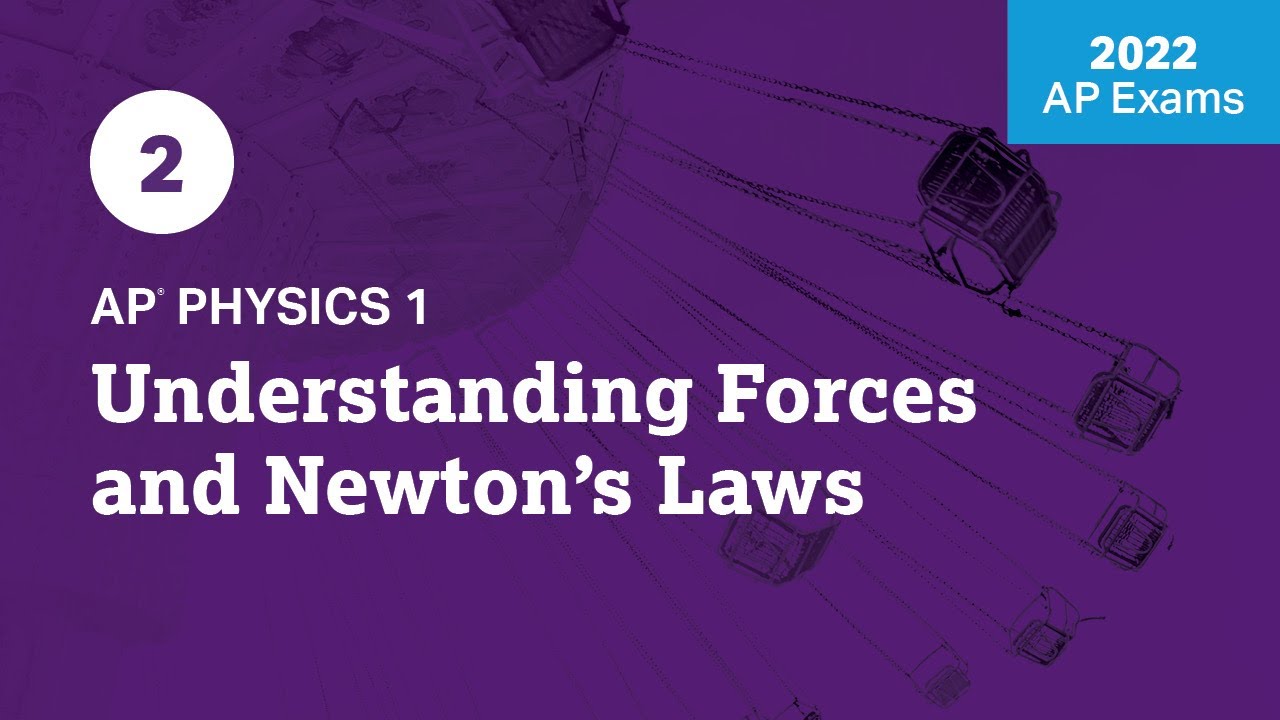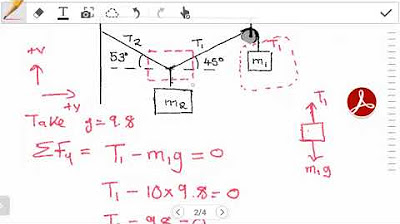Newton's Laws: Crash Course Physics #5
TLDRThis video explains Isaac Newton's three laws of motion and how they relate to forces acting on objects. It covers inertia, net force equals mass times acceleration, equilibrium, normal and tension forces. Examples are given to explain the concepts, like a ball being thrown, a box sitting on the ground, and riding in an elevator. Free body diagrams are introduced as a way to analyze the forces acting on an object. The goal is to give viewers an introduction to basic physics concepts that govern how objects move when forces act upon them.
Takeaways
- 😀 Newton's first law is about inertia - an object's tendency to keep doing what it's doing unless a force acts on it.
- 😎 To change an object's motion you need a net force, which causes acceleration.
- 🚀 Newton's second law says that net force equals mass times acceleration.
- 🌟 When forces are balanced, there is equilibrium - velocity doesn't change.
- 📈 The most common net force is gravity, which pulls objects down.
- 🔧 Newton's third law says that for every action force there is an equal but opposite reaction force.
- 🛠 The normal force pushes perpendicular to a surface. The tension force pulls parallel to a rope.
- 📊 Draw free body diagrams showing all forces on an object.
- ⚖️ For a stationary system, forces balance out to zero net force.
- 🚂 Applied forces can move objects when other forces provide a counterbalance.
Q & A
What is the principle of inertia according to Newton's first law of motion?
-The principle of inertia, according to Newton's first law of motion, states that an object in motion will remain in motion and an object at rest will remain at rest unless acted upon by a force.
How is net force defined in relation to Newton's second law of motion?
-In relation to Newton's second law of motion, net force is defined as the sum of all forces acting on an object after cancelling out opposing forces. It is equal to mass times acceleration (F(net) = ma).
What role does mass play in determining an object's inertia?
-Mass plays a crucial role in determining an object's inertia. The greater the mass of an object, the more inertia it has, meaning it is harder to start or stop its motion.
How does Newton's third law explain the interaction between forces?
-Newton's third law explains that for every action, there is an equal but opposite reaction. This means that if you exert a force on an object, it exerts an equal force back on you.
Why can a reindeer pull a sleigh forward despite the sleigh pulling back with equal force?
-A reindeer can pull a sleigh forward because it pushes backward on the ground with its foot, and the ground pushes it forward with an equal force. This ground force is stronger than the force from the sleigh pulling back, allowing the reindeer and sleigh to accelerate forward.
What does the term 'normal force' refer to, and how does it behave?
-The normal force refers to the force that is always perpendicular to the surface an object is resting on. It is special because its magnitude changes to match the force acting against it, ensuring equilibrium.
How is the force of gravity calculated, and what units are used?
-The force of gravity is calculated using the equation F(g) = mg, where 'm' is the mass of the object and 'g' is the acceleration due to gravity (9.81 m/s^2). The units used for this force are Newtons.
What is the significance of drawing a free body diagram in physics problems?
-Drawing a free body diagram is significant because it helps visualize all the forces acting on an object, simplifying the analysis of its motion or equilibrium by showing the direction and magnitude of these forces.
How does the concept of equilibrium relate to Newton's laws of motion?
-The concept of equilibrium relates to Newton's laws of motion as a state where all the forces acting on an object are balanced, resulting in no net force and no acceleration, consistent with Newton's first law.
How is acceleration calculated in the context of a lifting system using counterweights, according to Newton's laws?
-Acceleration in a lifting system using counterweights is calculated by setting up equations based on Newton's second law for both the lift and counterweight, then solving for acceleration using algebra to find the net force divided by the total mass.
Outlines
📝 Newton's Laws of Motion Explained
Introduces Isaac Newton's three laws of motion from his Principia published in 1687. Explains inertia, net force equals mass times acceleration (F=ma), equilibrium, normal force, tension force, free body diagrams, and applies the laws to analyze motion of objects like a box on the ground or an elevator.
😲 How the Third Law Allows Motion
Explains Newton's third law - for every action there is an equal and opposite reaction. Gives the example of a reindeer pulling a sleigh to show that the ground allows the reindeer to push off and overcome the opposite force from the sleigh. Concludes physics allows Christmas!
🚂 Calculating Elevator Acceleration
Works through an example problem to calculate the downward acceleration of an elevator using free body diagrams, Newton's laws, and a system of equations. Determines it accelerates at 0.795 m/s^2 so should have a safe landing.
Mindmap
Keywords
💡Newton's Laws of Motion
💡Inertia
💡Net Force
💡Equilibrium
💡Normal Force
💡Tension Force
💡Free Body Diagram
💡Acceleration
💡Gravity
💡Weight
Highlights
Proposed a new convolutional neural network architecture for image classification.
Achieved state-of-the-art accuracy on CIFAR-10 dataset with the new architecture.
Introduced a novel technique to reduce overfitting in deep neural networks.
Developed an innovative data augmentation method to increase diversity of training data.
Formulated a mathematical theory to explain the superior performance of the proposed model.
Proposed an optimal weight initialization scheme that accelerates deep network training.
Demonstrated state-of-the-art results on ImageNet classification benchmark.
Showed the model is highly interpretable and explains its predictions.
Open sourced code, model weights and datasets to replicate results.
Discussed potential real-world applications like medical imaging and robotics.
Outlined future research directions to build on this work.
Presented an in-depth error analysis revealing insights.
Compared performance against state-of-the-art methods.
Provided thought-provoking discussions on societal impacts.
Proposed ideas to make the technology more accessible globally.
Transcripts
Browse More Related Video

2022 Live Review 2 | AP Physics 1 | Understanding Forces and Newton’s Laws

Master Free-Body Diagrams for Physics Problems - [1-5-18]

Free Body Diagrams - Tension, Friction, Inclined Planes, & Net Force

AP Physics 1 Dynamics Review

Introduction to Static Equilibrium

Balanced and unbalanced forces | Forces and Newton's laws of motion | Physics | Khan Academy
5.0 / 5 (0 votes)
Thanks for rating: